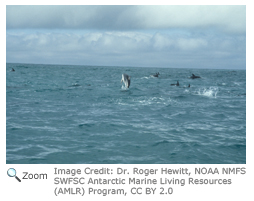Ocean Zones |
If you look beneath the surface of the open ocean, you'll find a diverse and unique environment. |
Plumbing the Ocean Depths
From Sunlight to Darkness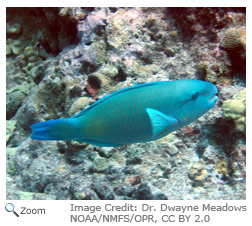 The pelagic region is divided into three zones. The top zone is the euphotic or sunlit zone. This is the ocean zone that sunlight penetrates. Because this zone gets sunlight, photosynthesis can occur and plants can grow here. The sunlit zone goes down to about 660 feet. The next zone is the dysphotic or twilight zone. Some sunlight reaches this zone, but not enough for photosynthesis to occur. The dysphotic zone goes down to about 3,300 feet. The last zone is the aphotic or midnight zone. No sunlight reaches this zone and it can reach depths of close to 20,000 feet. Sometimes people divide the midnight zone into two zones: the aphotic zone and the abyss. The pelagic region is divided into three zones. The top zone is the euphotic or sunlit zone. This is the ocean zone that sunlight penetrates. Because this zone gets sunlight, photosynthesis can occur and plants can grow here. The sunlit zone goes down to about 660 feet. The next zone is the dysphotic or twilight zone. Some sunlight reaches this zone, but not enough for photosynthesis to occur. The dysphotic zone goes down to about 3,300 feet. The last zone is the aphotic or midnight zone. No sunlight reaches this zone and it can reach depths of close to 20,000 feet. Sometimes people divide the midnight zone into two zones: the aphotic zone and the abyss. Let the Sun Shine In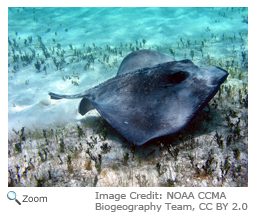 The sunlit zone is home to a wide variety of marine species because plants can grow there and water temperatures are relatively warm. Lots of marine animals can be found in the sunlit zone including sharks, tuna, mackerel, jellyfish, sea turtles, seals and sea lions and stingrays. There are not a lot of places to hide in the sunlit zone! Some species have an adaptation called countershading. These animals are dark on the top and lighter on their undersides. When a predator is looking down on them from above, they blend into the darker waters below. When a predator is looking at them from below, they blend into the lighter waters above. The sunlit zone is home to a wide variety of marine species because plants can grow there and water temperatures are relatively warm. Lots of marine animals can be found in the sunlit zone including sharks, tuna, mackerel, jellyfish, sea turtles, seals and sea lions and stingrays. There are not a lot of places to hide in the sunlit zone! Some species have an adaptation called countershading. These animals are dark on the top and lighter on their undersides. When a predator is looking down on them from above, they blend into the darker waters below. When a predator is looking at them from below, they blend into the lighter waters above. |
Entering the Twilight Zone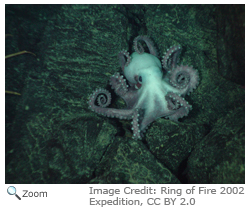 Animals that live in the twilight zone must be able to survive cold temperatures, an increase in water pressure and dark waters. There are no plants in this zone, because there is not enough light for photosynthesis. Octopus, squid, and the hatchet fish are some of the animals that can be found in this zone. Animals that live in the twilight zone must be able to survive cold temperatures, an increase in water pressure and dark waters. There are no plants in this zone, because there is not enough light for photosynthesis. Octopus, squid, and the hatchet fish are some of the animals that can be found in this zone. Many animals in this zone have thin bodies that help them hide from predators. Other organisms in this zone are red or black in color to better blend in with the dark water. When a predator is looking up at them, they are so thin that they are hard to see! 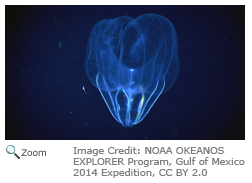 Some fish, like viper fish and the hatchet fish, have sharp fangs and large mouths that help them catch food. Other fish have large eyes that help them see in the dark waters. Most of the fish in this zone don't chase their food. They either stalk it or wait for it to float or swim by. Some animals that live in this zone make their own light with bioluminescence. They make light with special organs in their bodies called photophores. The photophores give off a greenish light. Some fish, like viper fish and the hatchet fish, have sharp fangs and large mouths that help them catch food. Other fish have large eyes that help them see in the dark waters. Most of the fish in this zone don't chase their food. They either stalk it or wait for it to float or swim by. Some animals that live in this zone make their own light with bioluminescence. They make light with special organs in their bodies called photophores. The photophores give off a greenish light.
Deep in DarknessIt is very cold and completely dark in the midnight zone. Water pressure can be as much as two tons per square inch. Life isn't easy here and this zone has fewer organisms than the other zones. Because there is no light in this zone, some animals don't have eyes. There are no plants in this zone.
|

